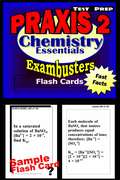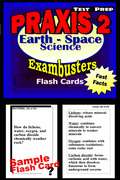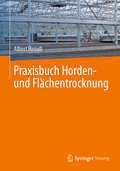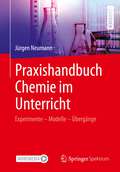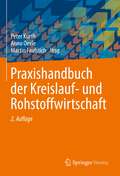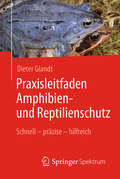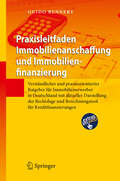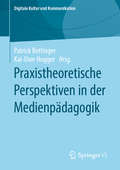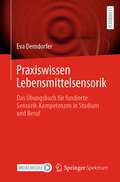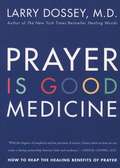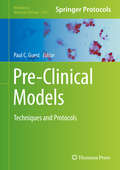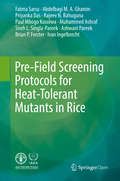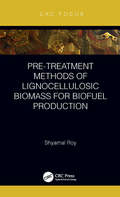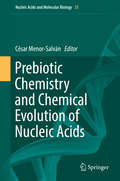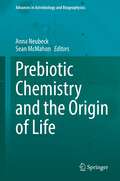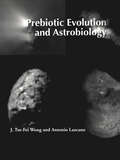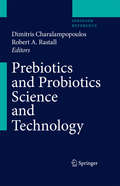- Table View
- List View
PRAXIS II Chemistry Test Prep Review--Exambusters Flash Cards: Chemistry Essentials (Exambusters PRAXIS II Workbook #3)
by Ace Inc.<P><P><i>Advisory: Bookshare has learned that this book offers only partial accessibility. We have kept it in the collection because it is useful for some of our members. Benetech is actively working on projects to improve accessibility issues such as these.</i><P><P> 700 questions and answers. Essential definitions, formulas, concepts, and sample problems. <P><P>Topics: Introduction, Matter, Atoms, Formulas, Moles, Reactions, Elements, Periodic Table, Electrons, Chemical Bonds, Heat, Gases, Phase Changes, Solutions, Reaction Rates, Equilibrium, Acids and Bases, Oxidation and Reduction, Introduction to Organic Chemistry, Radioactivity <P> EXAMBUSTERS PRAXIS II Prep Workbooks provide comprehensive PRAXIS review--one fact at a time--to prepare students to take practice PRAXIS tests. Each PRAXIS study guide focuses on fundamental concepts and definitions--a basic overview to begin studying for the PRAXIS exam. Up to 600 questions and answers, each volume in the PRAXIS series is a quick and easy, focused read. Reviewing PRAXIS flash cards is the first step toward more confident PRAXIS preparation and ultimately, higher PRAXIS exam scores!
PRAXIS II Physics Test Prep Review--Exambusters Flash Cards: Physics Essentials (Exambusters PRAXIS II Workbook #4)
by Ace Inc.<P><P><i>Advisory: Bookshare has learned that this book offers only partial accessibility. We have kept it in the collection because it is useful for some of our members. Benetech is actively working on projects to improve accessibility issues such as these.</i><P><P> 600 questions and answers. Essential definitions, formulas, concepts, and sample problems. <P><P>Topics: Measurement, Motion and Forces, Work and Energy, Heat and Gases, Atoms, Fluids, Sound, Light and Optics, DC Circuits, Magnetism, AC Circuits <P> EXAMBUSTERS PRAXIS II Prep Workbooks provide comprehensive PRAXIS review--one fact at a time--to prepare students to take practice PRAXIS tests. Each PRAXIS study guide focuses on fundamental concepts and definitions--a basic overview to begin studying for the PRAXIS exam. Up to 600 questions and answers, each volume in the PRAXIS series is a quick and easy, focused read. Reviewing PRAXIS flash cards is the first step toward more confident PRAXIS preparation and ultimately, higher PRAXIS exam scores!
PRAXIS II Test Prep Flash Cards: Earth/Space Sciences (Exambusters PRAXIS II Workbook #1)
by Ace Inc.<P><P><i>Advisory: Bookshare has learned that this book offers only partial accessibility. We have kept it in the collection because it is useful for some of our members. Benetech is actively working on projects to improve accessibility issues such as these.</i><P><P> 600 questions and answers. Essential definitions and concepts. <P><P>Topics: Calculations, Earth's Origin, Save Our Planet, Minerals, Rocks, Weathering, Groundwater, Running Water, Glaciers, The Changing Crust, The Oceans, Maps, The Atmosphere, Wind, Weather Patterns, Introduction to Astronomy <P>EXAMBUSTERS PRAXIS Prep Workbooks" provide comprehensive PRAXIS review--one fact at a time--to prepare students to take practice PRAXIS tests. Each PRAXIS study guide focuses on fundamental concepts and definitions--a basic overview to begin studying for the PRAXIS exam. Up to 600 questions and answers, each volume in the PRAXIS series is a quick and easy, focused read. Reviewing PRAXIS flash cards is the first step toward more confident PRAXIS preparation and ultimately, higher PRAXIS exam scores!
Praxisbuch für die Hydrometrie: Anleitung zur Abflussmessung in Fließgewässern
by Stefan SiedschlagDie Messung der Wassermenge ist eine der wichtigsten Grundlagen für die Lösung verschiedenster hydrologischer Fragestellungen und wasserwirtschaftlicher Aufgaben. Dieses Fachbuch hilft auf anschauliche und leicht verständliche Weise bei der Auswahl geeigneter Messstellen, Messgeräte und Messmethoden zur Abflussmessung in Fließgewässern. Ausgehend von den hydraulischen Eigenschaften fließender Gewässer und unter Bezugnahme auf die aktuell anerkannten Regeln der Technik werden mobile und stationäre Messgeräte in ihren Messprinzipien und ihrer praktischen Anwendung vorgestellt. Einfache Schritt-für-Schritt-Anleitungen machen die einzelnen Arbeitsvorgänge verständlich und für jedermann nachvollziehbar.
Praxisbuch Horden- und Flächentrocknung
by Albert HeindlDieses Fachbuch stellt die Horden- und Flächentrocknung in Theorie und Praxis vor. Es bietet Hinweise für die Auslegung, den praktischen Betrieb und die Lösung auftretender Probleme. Beschrieben werden absatzweise und quasikontinuierliche Horden- und Flächentrockner für Warmluft- und Vakuumtrocknung in verschiedenen Industriebereichen und in der Landtechnik. Auf die Nutzung der Solarstrahlung, von Abwärme und von Wärmepumpen in der Energiezufuhr wird eingegangen. Berechnungsbeispiele für die Auslegung und die Wirtschaftlichkeit des Betriebes werden aufgeführt. Ein besonderes Anliegen hierbei ist es, die Theorie der Trocknung mit der Praxis zu verbinden, weshalb immer wieder Praxisbezüge auch in den theoretischen Teil einfließen. Abgerundet wird das Buch durch daas Eingehen auf Arbeitsschutz, Emissionen und die Trocknungsqualität.Die ZielgruppenLandwirte und Agrargenossenschaften, die sich mit der Trocknung von Hopfen sowie Arznei- und Gewürzpflanzen befassenForstämter, welche eine Frostsamentrocknung betreiben,Kläranlagenbetreiber, welche sich mit der solaren Flächentrocknung von Klärschlamm beschäftigen Betreiber von Trocknungsanlagen für Obst und Gemüse im mittelständischen MaßstabStudenten der Agrarwissenschaften, Lebensmitteltechnologie und VerfahrenstechnikBetriebsleiter in der chemischen und pharmazeutischen Industrie, welche kleine Chargen wertvoller Chemikalien oder Pharmazeutika trocknen wollenBetriebsleiter in der Lebensmittelindustrie, mit Fokus auf Gefriertrocknung hochwertiger LebensmittelBetreiber von Schnittholztrocknungsanlagen
Praxishandbuch Chemie im Unterricht: Experimente – Modelle – Übergänge Illustriert und erläutert mit Tafelbildern aus dem Unterricht
by Jürgen NeumannWie gelangt man im Unterricht zu den verschiedenen Vorstellungen über den Aufbau von Atomen? Welche Experimente eignen sich hierfür als „Brückenexperimente“? Praxisorientiert und verständlich führt Jürgen Neumann Studenten des Lehramts Chemie in die Grundlagen der Chemie für den Unterricht ein; im Zentrum steht hierbei das Experiment als wesentlicher Schritt auf dem Weg zum Erkenntnisgewinn. Es werden am Experiment orientierte Wege beschrieben, die sich als Übergänge im Sinne der fachlichen Erweiterung und Vertiefung chemischer Grundlagen für Mittel- und Oberstufe verwenden lassen; eine ideale Ergänzung zu einschlägigen Grundlagenlehrbüchern und eine Hilfe für die Planung und Durchführung experimenteller Unterrichtsinhalte. Illustriert und ergänzt werden die chemischen Grundlagen und Zusammenhänge durch zahlreiche einprägsame Tafelabbildungen, unterstützende Videoclips zu Experimenten im Unterricht sowie historische Daten. Damit richtet sich dieses Praxishandbuch auch an Studierende des Lehramts Biologie zur fachlich-experimentellen Vertiefung chemischer Zusammenhänge, an Fachkolleginnen und -kollegen der Chemie sowie anderer Fachrichtungen und zur eigenen Inspiration. Viele der vorgestellten Experimente sind unter Verwendung von Plastikmaterialien aus der Medizin und Labortechnik konzipiert, die eine kostengünstige sowie Gefahrenstoff- und Verletzungsgefahr reduzierte Alternative zu gängigen, auf Glasmaterialien basierten Experimenten darstellen und sich im Unterricht mit geringem Zeitaufwand realisieren lassen. Ein Nachschlagewerk für alle Interessierten, die auf der Suche nach der Bedeutung von Modellen im Chemieunterricht sowie der Erklärung zu vielen Experimenten in der Schule sind; auch Experimente zu aktuellen Themen wie elektrisch leitende Kunststoffe und der Lithium-Ionen-Akku sind ein Thema.
Praxishandbuch der Kreislauf- und Rohstoffwirtschaft
by Peter Kurth Martin Faulstich Anno OexleDie traditionell vielschichtige Abfallwirtschaft entwickelt sich mit der ihr eigenen Dynamik zur Kreislauf- und Rohstoffwirtschaft. Im vorliegenden Handbuch werden erstmalig alle wesentlichen Aspekte dieses Wirtschaftssektors – fachübergreifend und interdisziplinär – behandelt. Neben den in der Ressourcenwirtschaft relevanten rechtlichen Fragestellungen (u. a. Stoffrecht, Verwaltungsrecht, Haftung und Transport) sind die unterschiedlichen Stoffströme dargestellt (z. B. Glas, Papier, Verpackung, Metalle und Elektronik-Altgeräte, Bioabfälle) sowie Anlagentechnik und Logistik beschrieben (Abfallwirtschaftssysteme, Abfallbehandlung, Deponierung). Bei der Auswahl der Themen und Autoren lag der Schwerpunkt auf Praxisrelevanz und Praxisbezug.
Praxisleitfaden Amphibien- und Reptilienschutz: Schnell - Präzise - Hilfreich
by Dieter Glandt Martin LayMit diesem handlichen Band werden Ihnen schnelle und zuverlässige Informationen in knapper übersichtlicher Form über alle mitteleuropäischen Amphibien- und Reptilienarten geboten.Frösche, Kröten, Unken, Molche, Salamander, Echsen und Schlangen in Deutschland, Österreich und der Schweiz werden behandelt. Dabei wird der Schwerpunkt auf die Gefährdung der Arten, deren Ursachen und besonders auf praktische Schutz- und Hilfsmaßnahmen gelegt.Studierende, freiberufliche Biologen, Landschaftsplaner und Naturschützer werden mit Gewinn dieses Nachschlagewerk bei Ihrer Arbeit nutzen. Interessierte Laien werden es gern in die Hand nehmen. Ziel der Maßnahmen soll sein, ein intaktes Netz in Verbindung stehender Populationen aufrecht zu halten oder dort, wo dies nicht der Fall ist, aufzubauen.Der Amphibien- und Reptilienschutz wird eingebettet in den Gesamtkomplex Naturschutz, wozu ein vorangestelltes allgemeines Kapitel dient. Verdeutlicht wird auch, dass diese Tiere einen wichtigen Stellenwert im Naturhaushalt (Stoffkreislauf) haben.
Praxisleitfaden Immobilienanschaffung und Immobilienfinanzierung
by Guido RennertDer Praxisleitfaden ist für alle diejenigen geschrieben, die in Deutschland eine (kreditfinanzierte) Immobilie kaufen oder selbst bauen wollen. Der Autor stellt das Thema anschaulich und leicht verständlich dar, wobei er prägnant und detailliert sowohl an rechtliche als auch an wirtschaftliche Fragestellungen heranführt. Die Inhalte werden anhand von Beispielen mit konkreten Berechnungen und Bezügen zur aktuellen Rechtslage illustriert. Das Berechnungs-Tool hilft bei der Ermittlung der tatsächlichen Kosten einer Kreditfinanzierung.
Praxistheoretische Perspektiven in der Medienpädagogik (Digitale Kultur und Kommunikation #6)
by Patrick Bettinger Kai-Uwe HuggerDer Band gibt einen Überblick über praxistheoretische Arbeiten im Bereich der Medienpädagogik. Anhand theoretischer und empirischer Beiträge wird das Feld praxistheoretischer Positionen vor dem Hintergrund medienpädagogischer Fragestellungen ausgeleuchtet. Die Beiträge nehmen Bezug auf aktuelle praxeologische Diskurse und Ansätze und stellen das Potenzial dieser Zugänge heraus. An verschiedenen Beispielen werden die vorgestellten praxistheoretischen Positionen hinsichtlich ihrer Möglichkeiten zur Erschließung von erziehungswissenschaftlich relevanten Phänomenen im Kontext der Digitalisierung veranschaulicht.
Praxiswissen Lebensmittelsensorik: Das Übungsbuch für fundierte Sensorik-Kompetenzen in Studium und Beruf
by Eva DerndorferLebensmittelsensorik umfasst das Prüfen von Lebensmitteln mit den menschlichen Sinnen. Um sie professionell ausüben zu können, bedarf es Fachwissen, Produkterfahrung, vor allem aber Routine in der Praxis. Dieses Lehrbuch enthält 50 Übungen zur Sinneswahrnehmung, Gaumenneutralisation, Probenvorbereitung, zu ausgewählten Prüfmethoden und zum Kombinieren von Lebensmitteln. Hierdurch schulen Sie Ihre eigenen Sinne, Ihr Geruchs- und Geschmacksgedächtnis und optimieren Ihre Riech- und Verkostungstechnik. Zudem erfahren Sie von Deskriptoren, um Lebensmittel zu beschreiben und lernen Kriterien kennen, warum Zutaten miteinander harmonieren.Dieses praktische Wissen hilft, um Verkostungen zu professionalisieren und zu standardisieren, Prüfpersonen auszuwählen und geeignete Schulungssubstanzen zu finden. Nur wer selbst viele verschiedene Proben vorbereitet hat, kennt die Wichtigkeit, aber auch die Komplexität, die die Probenvorbereitung mit sich bringen kann – und kann auch andere entsprechend anleiten. Alle Übungen sind im Selbststudium zeitlich und örtlich unabhängig durchführbar. Abrufbare Videos unterstützen das Lernen multisensorisch, Case Studies betten das geübte in einen Unternehmenskontext ein. Studierende der Lebensmittel- und Ernährungswissenschaften sowie verwandter Studiengänge profitieren von diesem praxisorientierten Lernansatz. Fachkräfte mit Bezug zur Sensorik – z. B. in der Gastronomie, Produktentwicklung oder Qualitätskontrolle – erhalten ein innovatives Übungsbuch zur Kompetenzerweiterung.
Prayer Is Good Medicine: How to Reap the Healing Benefits of Prayer
by Larry DosseyPrayer moves into the center stage of Western medicine Prayer Is Good Medicine acts as a modern-day prayer book as well as an ethical touchstone for healers and seekers. Unlike medical practitioners in the East, many physicians in the West argue that the healing power of science is far superior to, and often incompatible with, the healing power of prayer. Yet, physician Dossey, attentive to the ways in which spiritual health affects bodily health, demonstrated in his Healing Words that the capacity of prayer to heal, combined with the capacity of science to heal, is far greater than the healing power of medicine alone. Using evidence from scientific studies regarding the beneficial effects of prayer on health, Dossey has here fashioned a kind of how-to manual for incorporating prayer into the process of healing. After first defining prayer as an attitude of the heart whose content is neither shaped by nor limited to a single religious tradition, Dossey then proceeds to explore the infinite variety of forms that prayer may take. Dossey's holistic vision challenges narrow religious views of prayer as well as conventional medical method of healing.
Pre-Clinical Models: Techniques And Protocols (Methods in Molecular Biology #1916)
by Paul C. GuestThis volume details reviews and protocols on the development and analysis of both cellular and animal-based pre-clinical models in a number of medical areas, including metabolic disorders, longevity, cancer, heart disease and psychiatric disorders. Written in the highly successful Methods in Molecular Biology series format, chapters include introductions to their respective topics, lists of the necessary materials and reagents, step-by-step, readily reproducible laboratory protocols, and tips on troubleshooting and avoiding known pitfalls.Authoritative and cutting-edge, Pre-Clinical Models: Techniques and Protocols aims to provide methods that describe the context of specific disease or therapeutic areas.
Pre-Deployment Stress, Mental Health, and Help-Seeking Behaviors Among Marines
by Carrie M. Farmer Christine Anne Vaughan Jeffrey Garnett Robin M. WeinickAs part of an evaluation of the Marine Corps Operational Stress Control and Readiness (OSCAR) program, this report describes the methods and findings of a large survey of marines who were preparing for a deployment to Iraq or Afghanistan in 2010 or 2011. The results are among the first to shed light on the pre-deployment mental health status of marines, as well as the social resources they draw on when coping with stress and their attitudes about seeking help for stress-related problems.
Pre-Employment Background Investigations for Public Safety Professionals
by Frank A. Colaprete***Author Radio InterviewJoin Dr. Frank A. Colaprete for an upcoming interview on the Privacy Piracy show on KUCI 88.9FM. Click here on September 2nd, 2013 at 8:00 a.m. PST to listen in.Pre-employment investigations have been the subject of intense review and debate since 9/11 made the vetting of applicants a critical function of every organization
Pre-Field Screening Protocols for Heat-Tolerant Mutants in Rice
by Abdelbagi M.A. Ghanim Ivan Ingelbrecht Brian P. Forster Ashwani Pareek Sneh L. Singla-Pareek Muhammed Ashraf Paul Mbogo Kusolwa Rajeev N. Bahuguna Priyanka Das Fatma SarsuThis open access book presents simple, robust pre-field screening protocols that allow plant breeders to screen for enhanced tolerance to heat stress in rice. Two critical heat-sensitive stages in the lifecycle of the rice crop are targeted – the seedling and flowering stages – with screening based on simple phenotypic responses. The protocols are based on the use of a hydroponics system and/or pot experiments in a glasshouse in combination with a controlled growth chamber where the heat stress treatment is applied. The protocols are designed to be effective, simple, reproducible and user-friendly. The protocols will enable plant breeders to effectively reduce the number of plants from a few thousands to less than 100 candidate individual mutants or lines in a greenhouse/growth chamber, which can then be used for further testing and validation in the field conditions. The methods can also be used to classify rice genotypes according to their heat tolerance characteristics. Thus, different types of heat stress tolerance mechanisms can be identified, presenting opportunities for pyramiding different (mutant) sources of heat stress tolerance.
Pre-treatment Methods of Lignocellulosic Biomass for Biofuel Production
by Shyamal RoyBioconversion of lignocellulosic biomass to biofuel is materially obstructed by the compositional and chemical complexity of biomaterials, resulting in a challenge in using these as raw materials for the biofuel production process. This book explains various lignocellulosic biomass pre-treatment methods with emphasis on concepts, practicability, mechanisms of action, and advantages and disadvantages and potential for industrial applications. It also highlights the main challenges and suggests possible ways to make these pre-treatment technologies feasible for the biofuel industry. Features Presents different pre-treatment technologies available for lignocellulosic biomass in a concise manner. Covers use of different pre-treatment methods in laboratory to industrial scales. Includes combined pre-treatment and deep eutectic solvents methods. Discusses problems related to industrial adaptation and corresponding economics of different techniques. Explores significant fuels and chemicals derived from lignocellulosic biomass. This book is aimed at graduate students and researchers working on biomass conversion, characterization, cellulose, hemicellulose, lignin, microbial enzymes, fermentation technology, and industrial biotechnology.
Prebiotic Chemistry and Chemical Evolution of Nucleic Acids (Nucleic Acids and Molecular Biology #35)
by César Menor-SalvánThe origin of life is one of the biggest unsolved scientific questions. This book deals with the formation and first steps of the chemical evolution of nucleic acids, including the chemical roots behind the origin of their components from the simplest sources in a geochemical context. Chemical evolution encompasses the chemical processes and interactions conducive to self-assembly and supramolecular organization, leading to an increase of complexity and the emergence of life. The book starts with a personal account of the pioneering work of Stanley Miller and Jeffrey Bada on the Chemistry of Origins of Life and how the development of organic chemistry beginning in the 19th century led to the emergence of the field of prebiotic chemistry, situated at the frontier between organic, geo- and biochemistry. It then continues reviewing in tutorial manner current central topics regarding the organization of nucleic acids: the origin of nucleobases and nucleosides, their phosphorylation and polymerization and ultimately, their self-assembly and supramolecular organization at the inception of life.
Prebiotic Chemistry and the Origin of Life (Advances in Astrobiology and Biogeophysics)
by Sean McMahon Anna NeubeckThis book presents an overview of current views on the origin of life and its earliest evolution. Each chapter describes key processes, environments and transition on the long road from geochemistry and astrochemistry to biochemistry and finally to the ancestors of today´s organisms. This book combines the bottom-up and the top-down approaches to life including the origin of key chemical and structural features of living cells and the nature of abiotic factors that shaped these features in primordial environments. The book provides an overview of the topic as well as its state of the art for graduate students and newcomers to the field. It also serves as a reference for researchers in origins of life on Earth and beyond.
Prebiotic Evolution and Astrobiology
by J. Tze-Fei Wong Antonio LazcanoWith the accelerating pace of genomic analysis and space exploration, the field of prebiotic evolution and astrobiology is poised for a century of unprecedented advances ahead, and there is a need for textbooks for students. The authors of this book, aware of the difficulty of covering the multifaceted subject by any single author, have decided to
Prebiotics and Probiotics Science and Technology
by Dimitris Charalampopoulos Robert A. RastallA comprehensive overview on the advances in the field, this volume presents the science underpinning the probiotic and prebiotic effects, the latest in vivo studies, the technological issues in the development and manufacture of these types of products, and the regulatory issues involved. It will be a useful reference for both scientists and technologists working in academic and governmental institutes, and the industry.
